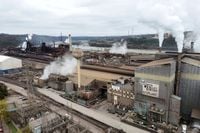On November 5, 2025, United States Steel Corporation (US Steel) unveiled an ambitious, multi-year growth plan in partnership with its new owner, Nippon Steel, marking a new era for the storied American steelmaker. The announcement, which comes just five months after Nippon Steel finalized its nearly $15 billion acquisition of US Steel, signals a massive $11 billion investment to modernize and expand US Steel’s operations by 2028. The plan aims to transform the century-old company into a global leader in advanced steel manufacturing, even as the industry faces significant headwinds from tariffs, shifting demand, and international competition.
The heart of the growth strategy lies in leveraging Nippon Steel’s cutting-edge technology and operational expertise. According to AP, the combined company—now the world’s fourth-largest steelmaker—will channel the $11 billion investment into a sweeping overhaul of US Steel’s facilities. This includes building a new facility in Arkansas that will introduce Nippon's advanced electrical steel sheet technology to the US market for the first time, a move designed to tap into the surging demand from the power grid and electric vehicle sectors. Additionally, major upgrades are planned for existing sites in Indiana and Pennsylvania, such as the modernization of the Gary Works Hot Strip Mill and the construction of a new slag recycler at Mon Valley Works.
US Steel CEO Dave Burritt expressed confidence in the partnership’s direction, stating, “We have a robust pipeline of growth projects, ranging from the modernization of our Gary Works Hot Strip Mill to the new slag recycler at Mon Valley Works and the development of new product capabilities. These initiatives are already delivering real results.” Burritt’s optimism is shared by many in the industry, who see the collaboration as a bold bet on the future of American manufacturing and infrastructure.
The financial stakes are high. The growth plan is projected to generate approximately $3 billion in profits, including $2.5 billion in additional EBITDA from capital investments over the next three years and another $500 million from operational efficiencies. According to GMK Center, more than 200 initiatives have been identified across all business segments, each focused on deploying Nippon Steel’s technologies to boost efficiency, improve product quality, and expand the product range. Nearly 50 Nippon Steel professionals have been embedded at US Steel facilities nationwide to help drive these changes.
Yet, the road ahead is not without challenges. Nippon Steel recently scaled back its earnings outlook, now expecting a net loss of 60 billion yen for the year ending March 2026, a sharp reversal from last year’s profit. This is due in large part to the pending results from the US Steel acquisition, as well as ongoing disruptions from tariffs that continue to roil the steel sector. Despite these obstacles, Nippon Steel remains bullish, banking on a rebound in steel demand by 2026 and betting that its investment will pay off as the US ramps up spending on infrastructure, the power grid, and electric vehicles.
The acquisition itself was a hard-fought victory. In June 2025, Nippon Steel completed its purchase of US Steel for more than $14 billion, ending a months-long battle for control of the Pittsburgh-based company. The deal was notable not only for its size but also for the national security considerations it raised. On June 14, 2025, then-President Donald Trump approved the acquisition, contingent on a national security agreement that included a “golden share” provision. This arrangement gives the US government the power to appoint a board member and influence certain company decisions, ensuring that domestic production and trade issues remain a priority. As reported by MT Newswires, the agreement underscores the political sensitivities surrounding foreign investment in critical American industries.
Labor and job creation are also central to the plan. US Steel says the investment is designed to “protect and create more than 100,000 jobs nationwide in the United States,” though it has not provided detailed specifics. The United Steelworkers International, the influential union representing many of the company’s workers, has voiced cautious support. David McCall, the union’s president, stated, “Since our first engagement with Nippon, we’ve been clear that investing in these workers and their facilities is the best use of the company’s resources. As Nippon and U.S. Steel begin to lay out their vision, we encourage them to prioritize this skilled, union workforce – now and well into the future.”
The modernization push is not just about expanding capacity; it’s also about sustainability and innovation. US Steel is expanding research and development to focus on “higher value, lower emission steel,” aiming to position itself at the forefront of the global transition to greener manufacturing. This dovetails with broader industry trends, as steelmakers worldwide race to reduce their carbon footprints and meet rising demand for environmentally friendly materials.
Nippon Steel’s US strategy is part of a larger realignment within the global steel industry. As reported by MT Newswires, the company is simultaneously trimming domestic operations in Japan and expanding its partnership with ArcelorMittal in India. These moves reflect a growing recognition that supply chains must be diversified and that companies must look beyond riskier home markets to secure their futures. By bringing advanced technology and investment to the US, Nippon Steel is betting that cross-border collaboration can deliver both economic and strategic benefits, even in an era of geopolitical uncertainty.
The investment also has significant implications for the broader industrial and materials markets. With the steel sector still reeling from tariff disruptions and global competition, Nippon Steel’s major commitment to the US sends a powerful signal of confidence in the country’s long-term manufacturing outlook. If successful, the plan could set a new standard for international cooperation in heavy industry, encouraging other global players to pursue similar partnerships and technology transfers.
Of course, not everyone is convinced that the path forward will be smooth. Tariff uncertainties, economic volatility, and the sheer scale of the transformation present formidable hurdles. Still, the willingness of both US Steel and Nippon Steel to make such a large, long-term bet—despite near-term profit pressures—suggests a belief that American industry is poised for a comeback. As Nippon Steel and US Steel roll out their vision, the world will be watching to see whether this historic partnership can truly deliver on its promise of revitalizing America’s steel heartland.
With a blend of technological innovation, strategic investment, and a focus on workforce development, the Nippon Steel-US Steel alliance is shaping up to be one of the most closely watched industrial stories of the decade.





